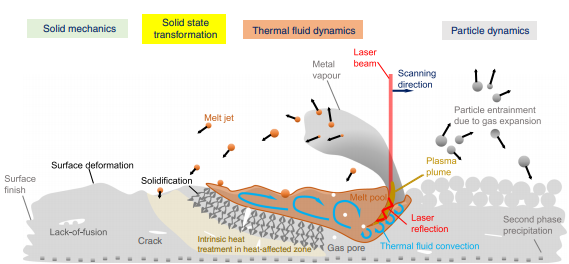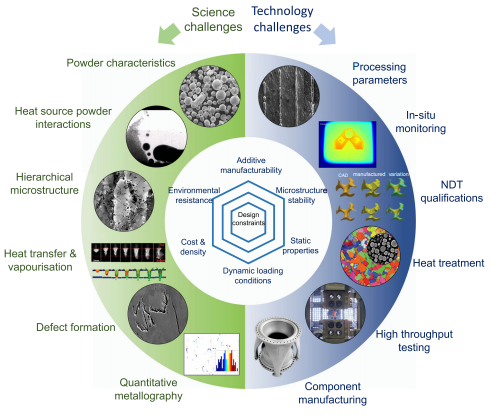Materials and manufacturing design for metal 3D Printing
We envisage carefully prescribed computer-aided design models along with model-based designer alloys and optimised--and indeed spatially varying--3D printing strategies to achieve highvalue added components11. One can imagine that these will be printed locally, provided that the 3D printing infrastructure needed is distributed (rather than centralised) and input materials are available.
The challenges are both scientific and technological; some critical ones are highlighted in Fig. 2. These are best addressed using data-driven approaches to account for the complex processing parameters from metal powder characteristics to large degree of freedom of printing strategy which respect the advances being made in data science, physics-based modelling, process modelling, and artificial intelligence12. The more technical aspects of AM such as the starting powder and the processing strategy are crucial for component consistency in terms of defect mitigation13 and quality assurance. While less fundamental, commercially implementing the AM process will necessitate multi-scale process modelling, improved in-situ monitoring14 and post-fabrication treatments, and the adoption of comprehensive industrial standards, especially because these alloys are designed for use in mission-critical applications in the aeronautics and space sectors.
With all these in mind, the materials design approach for superalloy AM requires the use of data from powder processing to melt and printing strategies to post-heat treatments--all in the name of consciously designing both the composition and processing route to achieve minimal defects, minimum waste, and desirable microstructure-properties relationships. Such an approach to manufacturing would allow for a more thoughtful and efficient method to engineer high-performance structural metallic components while respecting the needs of the environment and promoting sustainability.

Fig. 1 A schematic illustration of multi-scale, multi-physics phenomena in powder-bed fusion AM. Different physical effects and associated physics
taken place during AM include powder particle dynamics due to gas expansion, thermal fluid dynamics capturing solid-liquid-vapour transition when
interacted with laser, solid state transformation such as precipitation once remelting and intrinsic heat treatment, and subsequent solid mechanics to deal
with damage mechanism such as cracking.

Fig. 2 Key challenges in science and technology for digitally designed metal 3D printing, after7,13–15. Fundamental understanding of the processing science includes powder flowability and powder shape distribution, interaction with heat source, hierarchical microstructure formed, defects mitigation and better quantification of metallurgical features. Challenges on the technology perspective includes parametric optimisation of processing, real-time monitoring, establishment of qualification standard, high throughput testing and manufacturing of scaled-up components. The design of superalloys for AM has to balance between manufacturability, mechanical integrity, stability and cost.

